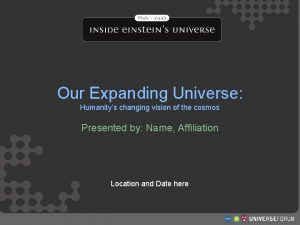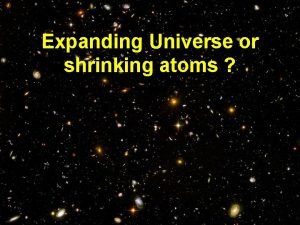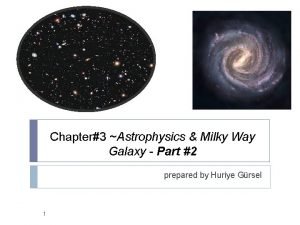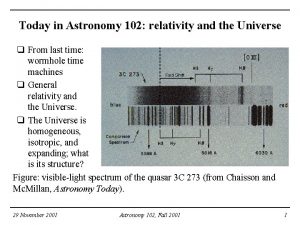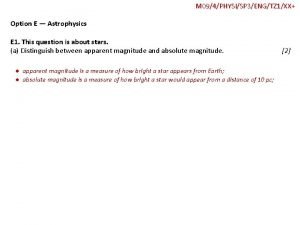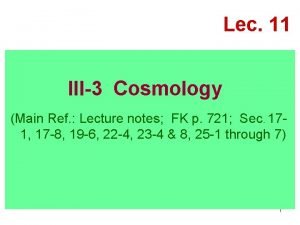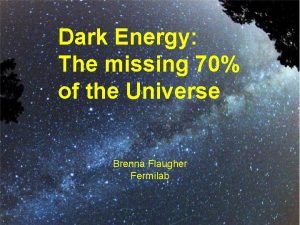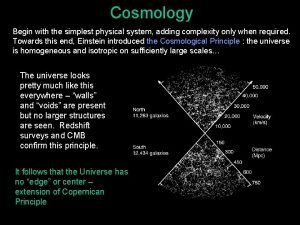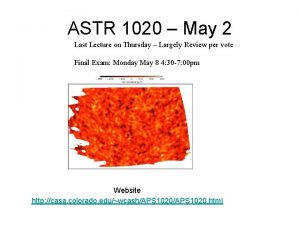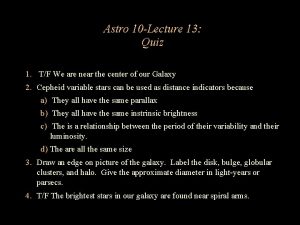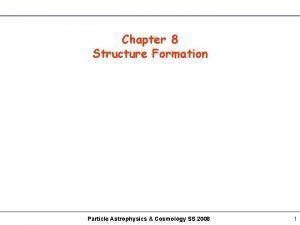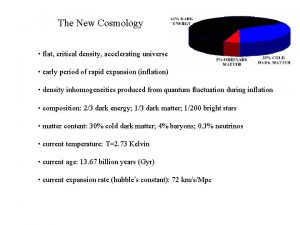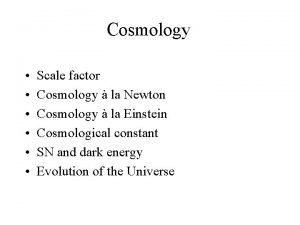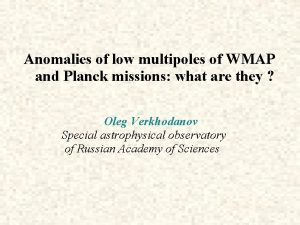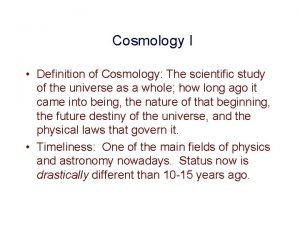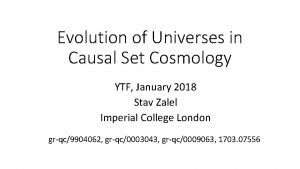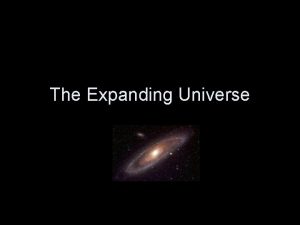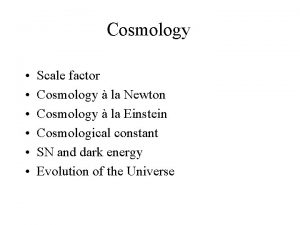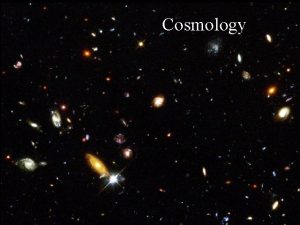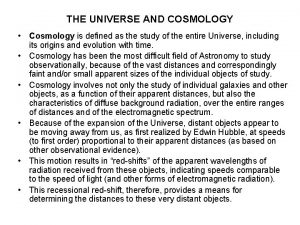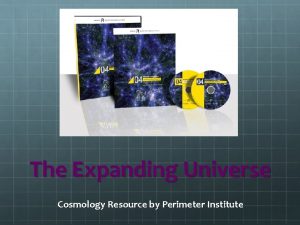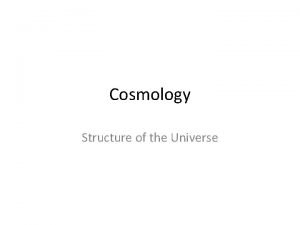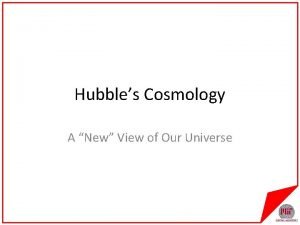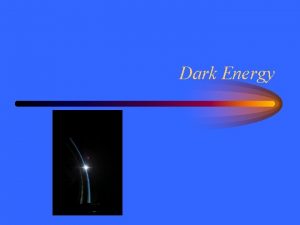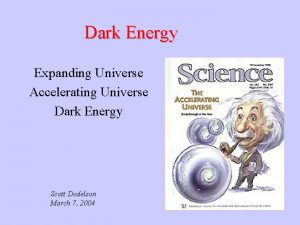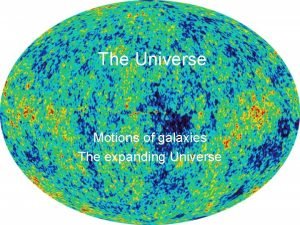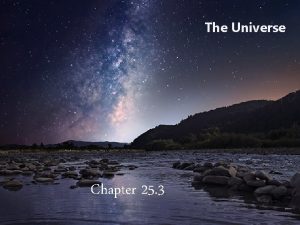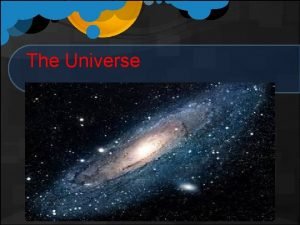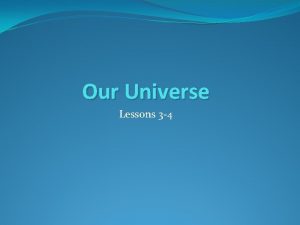The New Cosmology Our Expanding Universe From a

















- Slides: 17

The New Cosmology: Our Expanding Universe

From a Flat to a Spherical Earth • From very early in human civilization, humans have tried to explain the universe. • An early Babylonian idea was that Earth was a flat stationary plate, and the sky above was like a moving dome, or a roof enclosing earth as a half-circle. • Later, the ancient Greeks figured out that Earth could not be flat. As travelers, the Greeks were navigating using the stars for orientation. One orientation point was the North Star. They noticed that starting out from Athens, the North star would hover just above the horizon, but the farther they traveled north, the further it would raise above the horizon. This could only be explained if the Earth was round and not flat. • They also experimented with sticks of equal length placed on different locations on earth, for example, one in Athens and one in Alexandria. They would place them standing in right angles to the Earth, and measure the shadows they were throwing at one particular date and time. They now noticed that when one stick at one date and time threw no shadow in Alexandria, the stick in Athens at the same date and time would have a shadow. If the earth were flat, they should throw the same shadow; only if it was curved, the shadows would be different. Below: a man, living on the flat earth, under a dome of sun, moon, and stars, try to break out of the dome and take a look at the other side. If he goes any further he falls down. That the earth was flat was obvious from sense experience: earth is experienced as flat and we don’t fall off. That the sky was moving was also obvious from experience, since all the objects in the sky seem to be moving around us in a half-circle from morning to dusk: the sun, the moon, the stars.

The Ptolemaic conception of the universe. To different renditions, First, a Medieval: Earth is not only in the center of the universe, it is also huge compared to the sun and the other planets orbiting it. Second, a more formal model illustrating the centered earth and the eight spheres. • The Greeks had the idea that the most perfect movement had to be circular. • The circle was the most perfect geometrical form, so if sun, moon, and star revolved around earth, they would do so in perfect circles. • Ptolemy elaborated on Aristotle’s ideas, and came up with a model of the universe, that would last for nearly two thousand years. • In the middle we have Earth, and revolving around earth, we have eight different spheres, that each of them control the movement of different bodies in the sky. The sphere closest to earth would thus account for the movement of the moon; the fourth sphere would be the sphere of the sun; the eighth sphere, farthest away, would be the sphere of the fixed stars. • The universe was like an onion. In the middle, the earth, from there you can go out layer by layer, until the eighth sphere. What was outside the onion, nobody knew or asked about. One assumed that this was the sphere of God and his heaven.

Problems with the Perfect Circles • There was problems with Ptolemy’s model. Not all bodies on the sky seemed to move in perfect circles. • Some bodies seemed to wander around in strange patterns, one therefore gave these bodies the name, planetos, the Greek for wanderer. • One tried to account for these strange movements by adding epi-circles to the original circles; one added a circle to the original circle, such that the second circle had a center moving with the original circle. ‘Strange movements’ could now be explained by epi-circles; and if not by one epi-circle, then by adding an extra epi-circle, creating an epi-epicircle, etc. • Ptolemy’s model survived. And when Christianity became the official religion in Europe, theologians adopted the model too, because of its simplicity and perfection. • The circle was still regarded as perfect; and could God have created the universe other than perfect? That the eighth sphere was a natural boundary of the universe also fit into Christian thinking. One had created enough space for heaven and hell. The church liked the model, and regarded every attack on it as heretic. Below we still have Ptolemy’s model. Earth is in the center, and various planets and stars are orbiting around it in perfect circles. But we see a modification of the model, because one has added to the perfect circles so-called epi-circles. Observation had shown the early physicist that the sky was filled with so-called ‘wandering stars’ (Planetos), that were wandering forth and back on the sky. How to solve the problem, without destroying the idea of perfect circles? By creating ‘epi-circles’!

The Copernican Revolution • The problem with the Ptolemaic model was the peculiar epi-circular movements. One problem was – as Copernicus understood – that every movement could be explained by means of epi-circles, depending on how big one made the circle and how many of them one invented to do the job. Therefore, epi-circles were applied dogmatically, and did not correspond to observable facts. Secondly, because of all these epicicles, and epi-circles, etc. , the Ptolemaic model had become extremely complex. • In physics you always seek the simplest explanation. And Copernicus realized that placing the sun in the center of the universe, and the planets orbiting this center, would both be simpler, and would explain observable fact, that before could not be explained. • In this new ‘helio-centric’ universe, earth was no longer stationary, and it was no longer the center of the universe. • Later Kepler took up the model, and refined it. but it was not before Galileo, the idea was supported with observable facts. • At this point, the new model began to concern the church, and they deemed the idea heretic, and forced Galileo to retract his observations. The two models below look the same, but everything has changed from one to the other. The first is the Ptolemaic; it is GEO-CENTRIC: the Earth in the center, the Sun orbiting around. The second is the Copernican; it is HELIO-CENTRIC: Sun in the center, and Earth is orbiting around

Newton and Gravity • Although the trinity, Copernicus, Kepler, and Galileo had suggested an entirely new picture of the universe, much remained unresolved. One for example did not know why the planets were forced into these orbits around the sun, and believed it had to be a kind of magnetic forces attracting them. • It was not before Newton, one understood the law of gravity. According to Newton’s law, two bodies will attract each other with a force that is proportional to their mass, and inverse proportional to their distance. If we have the bodies, Earth and an apple, the two bodies attract each other, but because the Earth is enormous compared to an able, we only experience a pull in one direction, the able falls downwards. Newton extrapolated, the moon also ‘falls downwards, ’ but because of the centrifugal force pulling it in the other direction, it would be held in a stable orbit around earth. • Since the gravitational force is a weak force, we don’t perceive two bodies of similar mass attracting each other on earth. Two apples on a plate attract each other, but not visibly. • However, if we talk about massive objects, like moon, planets, sun, then the attraction is significant. The pull of the gravitational force keep them in place. Otherwise, they would just be moving in straight lines through space. In one body’s orbit around another body, there is a balance between the gravitational pull in one direction, and the centrifugal force in the other. Thanks to this balance, planets orbit around stars, and moons around planets. • Newton’s law for Gravitational attraction: “each body in the universe is attracted toward every other body by a force that is stronger the more massive the bodies and the closer they are to each other. ” Hawking, p. 5 • Below: two bodies with the masses M and m. The force of the gravitational attraction one finds by multiplying M and m, and the gravitational constant, G, and thereupon divide the result by the square of the distance between the bodies.

Distances in the Universe: Planets, Stars, and Galaxies • During the history of Cosmology our image of the universe has continuously been expanding. The universe not only expends in actuality, it expands in our imagination. Historically, it was first nothing but a flat earth with a dome on top; then it became a solar system; then a galaxy; then astronomers started to speculate on the existence of other galaxies; today we know that our visible universe consists of 1 -200 billion galaxies. We also know that this is only our observable universe and that it must be bigger. Cutting edge cosmology speculates that there may exist an infinite number of alternative universes; that we consequently live in a “multiverse. ” • When we measure distances in the universe, we no longer measure in kilometers, but in light-years. The distance traveled by light in one year is a light-year. It takes the light of the sun eight minutes to travel to earth, so the sun is eight light minutes away from us. It takes light from the star closest to our own (Alpha Centauri) about four years to travel to us, so, it is four light-years away from us. • If we adopt a scale where the Sun is an orange and Earth is a pinhead, the distance between the orange and pinhead is around 15 meters.

Our Address in the Universe • In our galaxy, the Milky Way, there are billions of stars like our sun (approximately 100 billions). We assume that there are billions of planets orbiting these stars, but we can’t detect them easily, because they are small and they don’t emit light. • Since there are billions of galaxies in the universe, and these billions of galaxies are composed of billions of stars, around which trillions of planets must be orbiting, astronomers seriously believe – given the huge number –that life must exist on some of these other planets. • Our location in the Milky Way is somewhat in the outskirts of the galaxy. It is fortunate that we are not too close to the center, because it consists of a super-massive black hole, that ribs everything apart coming too close.

Speed of Light • Einstein discovered that light has a speed, and it is invariable. It takes time for light to travel. A thousand kilometers takes around 0. 0033356 second, and a million kilometers 3. 3356 seconds. In other words, light travels at a speed of approximately 300, 000 kilometers per second. • Since light has an invariable speed, and we know its value, we can measure distances by measuring the time it takes for light to travel from one event to another (therefore, we no longer measure distances in a metrical system). In Hawking’s illustration to the right, one sends a pulse of radio-waves (traveling with the same speed as light) out to an object, and measure the time it takes for it to be reflected back. Time is measured on the vertical y-axis; while distance is measured on the horizontal x-axis. To know the distance to the object, we take the time for the pulse to be reflected back to us, divide it by two (since it took a round-trip), and multiply time with the speed of light. Consequently, we have the distance to the object. • We have said that the distance from the sun to Earth is about 8 Light-minutes. This means that the sunlight we see now is eight minutes old, or, it was emitted eight minutes ago. It also implies that we can know nothing about the sunlight that is being emitted in our present now. And since nothing travels faster than light, there is no way we can know the present • On Hawking’s illustration to the left, we have the Sun and the Earth lined up at time 0 on the x-axis. Time 0 represents the absolute present. At time 0, we imagine that the sun implodes and disappears; however, Earth is still unaffected, because it is outside the light cone of the sun; it is in what Hawking calls the Elsewhere. As the clock ticks, we move up along the vertical time axis, and after 8 minutes, we enter the light cone of the sun, and experience what happened 8 minutes ago, that the sun has vanished.

The Light Cone • When we enter the sun’s light-cone, we experience the implosion, although it is eight minutes old. It is in the so-called absolute past — that is, from our point of view. There are light cones for as well absolute future and absolute past. They are relative to what we decide is the present observation point. The light cone in the figure illustrates the relations between absolute past, present, and absolute future. The Future and Past Light Cone • When we observe galaxies and galaxy clusters, we only see what is past. The father away the object is, the longer it takes for its light to reach us, and the further we look back into the Past Light Cone. • What happens in our present, we cannot know; we cannot know what space is on the so-called Hyper-Surface of the Present. • Relative to the Future Light Cone of an object, we are in the Elsewhere; only as time passes, we move into the light emitted from the object.

On a Cosmological Scale we can never Know the Present • When applying these insights to the universe as a whole, we understand that we always only see the absolute past. The present of a distant galaxy is from our point of view in the absolute future, and we have absolutely no access to the absolute future. In relation to the absolute future we are in the Elsewhere. We are consequently limited to observe the absolute past. We see only galaxies from which light has been traveling for millions and billions of years. So, the deeper we look in the universe, the younger a universe we see. • There is certainly a universe of galaxies co-present to our galaxy (the so-called “Hyper. Surface of the Present” on figure above), but we cannot observe it, because light has not arrived yet. • It is also not possible to overcome that barrier and somehow take a peak at what our co-present universe looks like, because light is a constant and it is not possible to travel faster than light. • When a body approximates the speed of light, it also increases in mass. This is a consequence of Einstein’s equation: E = mc 2. There is a correlation between energy and mass; it takes still more energy to accelerate an object that will have still larger mass as it approaches the speed of light. Near the speed of light the mass would be infinite, and one would need infinite energy to move it. • We can compare it to a car. If you want it to go faster, you also need to equip the car with a larger more powerful engine, but with this you increase the mass of the car. The faster you want the car to go, the bigger the engine has to be, but the heavier becomes the car. Near the speed of light, you would need such a huge engine that the mass of

Doppler Effect and Red-shift In order to understand the next discovery about our universe, we must understand the doppler effect. The doppler effect is well-known in our experience of sound. When for example a car comes toward us, the sound of the car increases in pitch (the sound waves are compressed), and when it moves away, the sound decreases in pitch (the sound waves are stretched out). As with the police-car in the example. When the sound moves toward us (when sound-waves are compressed), the waves are blue-shifted. When the sound moves away from us, the waves are red-shifted. The same is the case with light. When observing light emitted by a star, one breaks it up into a spectrum spanning from the deep red to the deep blue. Depending of the chemical composition of the star, the spectrum reveal patterns of absorptions lines (i. e. , patterns of dark lines in the spectrum that indicates the presence of various elements, such as Helium, Hydrogen, Carbon, etc. ) From the laboratory we know these patterns well enough, and from looking at them the astronomer can quickly determine the star’s chemical composition. However, as in sound, there is a difference in the light spectrum according to whether the object moves away from us, or toward us. If it is moving toward us, the pattern of absorption lines is ‘shifted’ toward blue. If it is moving away from us, the pattern is ‘shifted’ toward red.

Hubble’s Discovery: Galaxies Move away from us In 1929, the astronomer Edwin Hubble applied the notion of the Doppler effect to his observations of galaxies. He expected to see a random distribution of blue-shifted and red -shifted galaxies, but observed instead that distant galaxies are moving rapidly away from us; they were all red-shifted. Furthermore, not only were galaxies moving away, but there was a correlation between their distance from us and their velocity. In other words, the father away they are from us, the faster they move away. In the model to the right, the x-axis represents the distance from the observer; the y-axis represents the velocity (speed) of the galaxy. Galaxies close to us, moves away from us with slower speeds. Distant galaxies moves away with higher speeds. The father away a galaxy is, the faster does it also move away. The relation is a constant (diagonal line; Hubble’s Constant: H 0 = 72)

The Universe is Expanding from a Singularity This observation could only imply that the universe is expanding, and more rapidly so, the deeper we go into the universe. The universe expands, like if you blow up a balloon, or set a raisin bread to rise. In the form of the raisins, you have certain points representing stars or galaxies. We choose one of the raisins to be our observation point, and in the vicinity of that point, we follow the expansion of other raisins. When the dough starts to raise, the raisins start to expand away from our observations point, and the further away they are, the more they expand. On the model, the point nearest us expands from 5 cm to 10 cm; the point farthest away from us expands from 10 cm to 20 cm. Understanding this logic, it did not much thinking to figure out that if galaxies are expanding, they must at some point have been closer together than they are now. If they are expanding today, they must have been closer together yesterday, and still closer the day before yesterday, and so on until we find a beginning of the expansion. Hubble was able to calculate the rate by which they expand, that is, the velocity of expanding galaxies. This made it possible to estimate the time it has taken the universe to expand this far, and estimate the distant beginning of the universe; a point called a singularity, or better known as the big bang. The universe was no longer eternal and unchanging. It had a beginning, and it was, and is still, constantly changing. The universe had a birth, a creation from where it came into being.

A Model of the Universe Expanding from an “Inflationary Hot Big Bang” Event • A model of the expanding universe. It starts in a super-hot Big Bang ‘explosion’ in the first fraction of a second (T = 10 -43). At this point, there are no particle formation and no physical forces; consequently no physical laws. • At T = 10 -32 seconds, this big bang singularity starts to inflate (with a doubling time of 1 picosecond). The model illustrates how the different forces starts to form, first strong, then weak, the electromagnetic, finally gravitational, and how the first particles start to form. • Not before at around one second after the ‘explosion, ’ light elements start to form like He, D, Li. The exploding universe continues to produce clouds of mass, until the gravitational effect takes over, and mass starts to collapse into stars and galaxies. After around 13. 7 billions years, the universe reaches is current state.

• To the left, we have a model that depicts us in the middle, as observing the universe. The universe is consequently all around us, and the deeper we look into the universe with advanced telescopes like Hubble, the earlier an universe we see. With the current telescopes with can see until the blue line, the so-called Hubble Ultra Deep Field, which approximately corresponds to the formation of the first galaxies. Further out we have the radiation era, the Cosmic Microwave Background, and the outer periphery would represent the Big Bang, 13. 7 billion years ago. In this perspective the Big Bang is all around us. We notice that the universe expands from the inner core, i. e. , from the center of the circle, pressing the periphery outwards • To the right, we have a model that depicts the Big Bang in the middle, therefore a ‘realistic’ model where the universe starts in the Big Bang, then expands up till the outer periphery, which represents the present state of the universe.

The Cosmic Microwave Background The white noise one picks up in radios and television sets is coming from the Cosmic Microwave Background, the universe as it had formed 400. 000 thousand years after the big bang. The Microwave Background is a plasma of high-density matter. Stars and galaxies have as yet not formed. The minute differences temperatures (in the order of 1/10, 000) can be picked up, and be depicted as in the colored map as below. These difference will eventually end up as the differences in galaxy concentrations in our universe. The Microwave Background is like the embryo of the universe. The existence of the Microwave Background is proof of the Big Bang theory and the expansion of the universe.
 Expanding universe
Expanding universe Is the universe expanding or shrinking
Is the universe expanding or shrinking Expanding universe
Expanding universe Expanding ever universe 18
Expanding ever universe 18 The universe expanding than
The universe expanding than The universe expanding than
The universe expanding than The universe expanding than
The universe expanding than The universe expanding faster than
The universe expanding faster than Cosmological redshift equation
Cosmological redshift equation Universe expanding faster should
Universe expanding faster should What is smaller than an atom
What is smaller than an atom Expanding universe
Expanding universe Cosmology
Cosmology Critical density
Critical density Scale factor cosmology
Scale factor cosmology Axis of evil cosmology
Axis of evil cosmology Definition of cosmology
Definition of cosmology Stav zalel
Stav zalel
